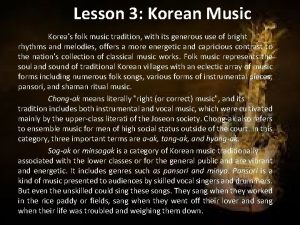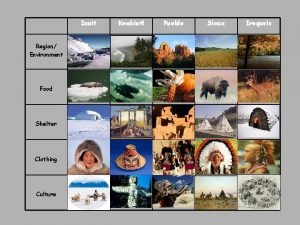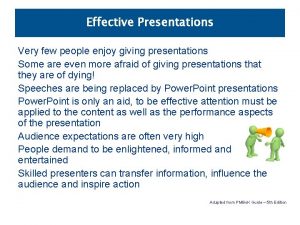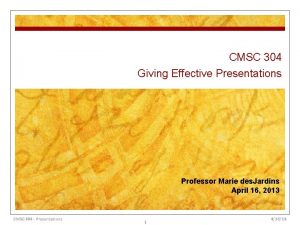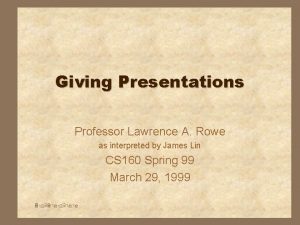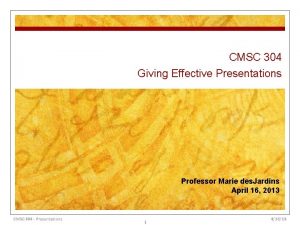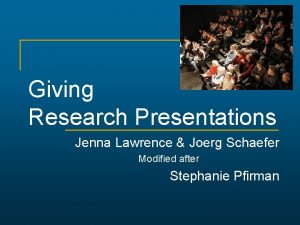GIVING RESEARCH PRESENTATIONS Jeffrey Shaman Associate Professor Dept




































- Slides: 36

GIVING RESEARCH PRESENTATIONS Jeffrey Shaman Associate Professor, Dept. of Environmental Health Sciences, Mailman School of Public Health Columbia University Supported in part by NSF Atmospheric and Geospace Sciences, NIH MIDAS Program, DOD Defense Threat Reduction Agency, and the NIH/NSF Joint Program in Mathematical Biology

“If you don’t kick things around with people, you are out of it. Nobody, I always say, can be anybody without somebody around. ” Physicist John Wheeler Your thinking improves, the more you talk about need to be seen and heard, to be known and rea Csikszentmihalyi, 1996 “Creativity”

How to Give an Effective Presentation: Structure Basic stucture Say 1 -3 main points in the introduction Say what you are going to say it Give the talk Then say what you said Summarize main points in the conclusion Don’t try to build suspense and then unveil a surprise ending http: //www. safetyoffice. uwaterloo. ca/hspm/t ools/images/scaffold_stair. png

http: //battellemedia. com/images/book_open. jpg Tell a Story Prepare your material so that it tells a story logically Subject: title, authors, acknowledgements Introduction/overview Method/approach Results/information/analysis Conclusion/summary Why and to whom are you giving this presentation? What do you want the audience to learn? Think about this as you construct your talk Edit your slides -- delete what is unnecessary, distracting, confusing, off point http: //www. cgd. ucar. edu/cms/agu/scientific_talk. html

Presenting Your Methods, Data, and Results Methods, Instrumentation For most talks, only present the minimum Data Tables are useful for a small amount of data Include units Indicate data source if they are not your own But tables are often used badly …

Results: Discharge & Precipitation at Esopus Creek Discharge of the Esopus Creek (Coldbrook, NY) and precipitation at Slide Mountain, NY (source: USGS/NCDC)

Esopus Creek Discharge of the Esopus Creek (Coldbrook, NY) and precipitation at Slide Mountain, NY (source: USGS/NCDC)

Figures ‘ 1 figure 1000 words’ Figures should be readable, understandable, uncluttered Keep figures simple, use color logically for clarification Blue = cold, red = warm, dark = little, bright = a lot Invisible color Meaning attached to colors (color blindness is more common than you think http: //www. cs. aau. dk/~luca/SLIDES/howtotalk-ru. pdf Explain axes and variables

Emk 1 knockdown inhibits lumen formation in MDCK cells: -RT-PCR: EMK 1 is effectively knocked down in MDCK cells 24 hours after transfection with PSUPER (control) or P-SUPER-si. EMK 1 plasmid; knockdown confirmed on the right with antibodies to EMK 1. - Collagen overlay assay: cells cultured 24 h on collagen I before being overlaid with additional collagen on the apical surface, analyzed 24 h later. Note the lack of lumen in EMK 1 -KO cultures. - Ca switch: control or EMK 1 -KO cells were plated in low Ca medium 24 h upon transfection with p. SUPER or p. SUPER-KO. After 12 h, cultures were switched to normal medium for 24 h. Transmission EM of cells sectioned perpendicular to the substratum shows lack of microvilli in EMK 1 -KO cells. http: //www. fw. msu. edu/orgs/gso/documents/GSOWorkshop. Docs. S p 2006/Presentation. Tipsin. Power. Point. ppt#428, 1, Tips for Preparing and Giving an Effective Scientific Presentation using Powerpoint

Results: Discharge & Precipitation at Esopus Creek Discharge of the Esopus Creek (Coldbrook, NY) and precipitation at Slide Mountain, NY (source: USGS/NCDC)

Results: Spectral reflectance of land cover components in a tundra burn scar

Cartoons & Concept Maps Create a summary cartoon, flow chart or concept map with major findings, or an illustration of the processes or problem Consider showing it at the beginning and the end You can use web sources for figures Include reference!

Preparing the Presentation Average not more than 1 slide per minute Powerpoint, Keynote, pdf are standard No sounds! Some logical animations good Use 3 -7 bullets per page If you use something else, be careful to check it in advance Avoid writing out, and especially reading, long and complete sentences on slides because it is really boring to the audience. One sentence that states the take home message on a simple figure slide can work well though. Slide appearance (font, colors) should be consistent Speelcheck

What Font to Use Type size should be 18 points or larger: 18 point 20 point 24 point 28 point 36 point AVOID USING ALL CAPITAL LETTERS BECAUSE IT’S MUCH HARDER TO READ * References can be in 12 -14 point font http: //www. fw. msu. edu/orgs/gso/documents/GSOWorkshop Docs. Sp 2006/Presentation. Tipsin. Power. Point. ppt#307, 6, Powe rpoint basics: 1. What font to use

Color Dark letters against a light background work Dark letters against a light background are best for smaller rooms, especially when the lights are on for teaching http: //www. fw. msu. edu/orgs/gso/documents/GSOWorkshop. D ocs. Sp 2006/Presentation. Tipsin. Power. Point. ppt#302, 5, Powerp oint basics: 1. What font to use

Color Light letters against a dark background also work Many experts feel that a dark blue or black background works best for talks in a large room http: //www. fw. msu. edu/orgs/gso/documents/GSOWorkshop Docs. Sp 2006/Presentation. Tipsin. Power. Point. ppt#302, 5, Powe rpoint basics: 1. What font to use

Preparing Yourself Immerse yourself in subject Familiar with the projection equipment, remote control … Web of Science/Google it: use the latest news Memory stick AND a laptop WITH power supply Print out copies of your slides (‘handouts’) Annotate and use as notes Review as you’re waiting Reference if everything crashes, the bulb blows www. terryfoxtheatre. com/theatre_specifications. htm

www. thomas. edu/facilities/auditorium/index. htm Rehearsing Practice – actually stand up and say the words out loud Discover what you don’t understand Develop a natural flow and come up better with phrasings and ways to describe things – no uptalk! Stay within the time limit Try speaking too loud to get a feeling where the upper limit is Don’t over rehearse or memorize the talk http: //www. fw. msu. edu/orgs/gso/documents/GSOWorksh op. Docs. Sp 2006/Tipsfor. Givinga. Scientific. Presentation. pdf

What to Wear … Dress up – maybe wear a jacket? More formal attire makes you appear more authoritative and you show you care enough to try to look nice From “Ask Dr. Marty” Animal. Lab. News (Jan. Feb 2007) Dark clothes are more powerful than light clothes Shirts or blouses with collars are better than collarless ones Clothes with pressed creases (!) are signs of power

Startin g Starting out is the hardest part of the talk Memorize the first few lines … “Hello, My name is Jeffrey Shaman. The title of my presentation is ‘Forecasting Outbreaks of Infectious Disease’. Infectious http: //soroptimistofgreaterdavis. org/doc uments/images/photos/speaker. gif disease remains a problem of both medical and public health importance, yet our ability to predict, and even anticipate, the intensity, spread and duration of http: //www. fw. msu. edu/orgs/gso/documents/G SOWorkshop. Docs. Sp 2006/Tipsfor. Givinga. Scie infectious disease epidemics ntific. Presentation. pdf

Eye Contact Experienced speakers: Speak freely and look directly at audience Remember to roam around the room – don’t lock onto 1 person! Inexperienced speakers: Put outline and key points of your presentation on your slides This procedure helps you be more comfortable You don’t have to remember what to say Eyes are on the slide not on you Key points are there in case you forget to say something and also for people who weren’t listening or who are visual learners http: //www. metclubnyc. org/slide%20 show. jpg

Presenting the Presentation Stand where the figures can be seen Track your talk using the monitor Not the screen Pace yourself (but don’t pace!) Figure out which slide is your half-way mark and use that to check your time http: //www. dvd-photo-slideshow. com/screenshot/01. gif

Some “Don’ts” Don’t apologize or make comments about yourself “I hope you’re not bored” “I was working on this ‘til 3 am” Don’t overuse the pointer Don’t try to be cute and don’t force being funny Don’t forget acknowledgements, always give proper credit Tip: Everyone in the audience has come to listen to your lecture with the secret hope of hearing their work mentioned

Concludin g Announce the ending so that people are prepared Have only a few concluding statements Come back to the big picture and summarize the significance of your work in that context For example, with a slide titled “Conclusions” Or by saying, “In my final slide …” or “My final point is …” Extend logically beyond your limited study – but don’t overreach Open up new perspective Describe future work, raise questions, potential implications http: //www. cs. aau. dk/~luca/SLIDES/howtotalk-ru. pdf

Finishing Think carefully about your final words and how to finish your presentation strongly Don’t just drift off … “I guess that’s all I have to say …” You may want to actually memorize your ending lines, just as you do your starting points Ending your talk Say “Thank You” … pause for applause … then Say “Any questions? ” http: //international. internet 2. edu/images/CLARAI 2 -Mo. U/i 2 -clara-applause. JPG

What Can Go Wrong? www. rcpsych. ac. uk/. . . / anxiety/images/grap 6. jpg Uncertainty about material Interruptions Running out of slides Running out of time http: //www. cs. aau. dk/~luca/SLIDES/howtotalk-ru. pdf

Uncertainty About the Material Best is if you are sure about the material you present Trim the other parts out – if possible If you have to address something important that you are unsure of … Acknowledge the gap in your understanding “I’m working on this part” or “I’m looking into it” Pose the issue in the future research section at the end From What's so Funny About Science? by Sidney Harris (1977) Or raise it as a question yourself …

Ongoing Work: Can we design a better particle filter?

Ongoing Work: How is influenza transmitted? Image: CDC

www. rscni. ac. uk/. . . /netmanage/networkindex. htm Interruptions During Your Presentation Don’t look irritated or rushed Answer – briefly – just enough to straighten it out A question that you will answer later in your talk? Then carry on with your presentation without checking back Say “Good point; just wait two slides” Requires a long answer and is not critical understanding? Say “Good point; I’ll come back to it at the end of the talk” http: //www. cs. aau. dk/~luca/SLIDES/howtotalk-ru. pdf

Finishing Too Fast http: //photolog. icyshard. com/archives/26 things 3/stretch. jpg Short talks are better than ones that are too long What to do: Don’t make a personal comment “hum, I’m running out of slides …” Stretch it a little -- see if you can think of an example, or story, to bolster your points Conclude unhurriedly, summarizing your main points, but don’t be repetitious http: //www. cs. aau. dk/~luca/SLIDES/howtotalk-ru. pdf

Running Out of Time “He cannot speak well that cannot hold his tongue” Thomas Fuller, 1732, Gnomologia Avoid this – impolite to other speakers and the audience: if it happens … Do not assume that you can carry on past your time Do not skip all of your slides looking for the right one to put on next Conclude – on time wherever you are in your talk -- by making your main points In Powerpoint you can just type the number of your concluding slide and press Enter to skip right to it http: //www. cs. aau. dk/~luca/SLIDES/howtotalk-ru. pdf http: //www. fw. msu. edu/orgs/gso/documents/GSOWorkshop. D ocs. Sp 2006/Cairns. Speaking. At. Length. pdf

Questions after your talk help you in writing up your research Identifies parts the audience did not understand Focuses and adds dimension to your analysis You can repeat the question – but don’t check back “Did I get it right? ” This gives you time to think The rest of the audience may not have heard the question (If you heard the question incorrectly, it presents an opportunity for clarification) http: //www. erp. wisc. edu/profdev/Talkhandout 05. doc http: //www. firekills. gov. uk/seniors/cool/howstart/images/howstart. gif

Preparing for Answers Usually you have thought more about the material than anyone else -- this puts you in a stronger position than you may think Keep your answers short and to the point -- don’t respond with another lecture Anticipate typical questions and prepare for them Generalizability of your findings to other times? Other places? Other conditions? Methodological bias? Uncertainties? Exceptions? Still concerned about questions? Make extra slides – perhaps on detailshttp: //www. regislasvegas. org/images/class-pic-hand-raised. jpg of instrumentation or methodology

Difficult Questions If you really don't know the answer Don't feel that you have to invent an answer on the fly -- you are only human and you can't have thought of everything Say “That’s a good point, let’s discuss it afterwards” If the questioner disagrees with you and it looks like there will be an argument then defuse the situation "We clearly don't agree on this point, let's go on to other questions and you and I can talk about this later" http: //www. erp. wisc. edu/profdev/Talkhandout 05. doc

Conclusions Presenting your research is critically important in advancing both your ideas and your reputation Structure your content in a way that is comfortable for you Use your own style to your advantage Think ahead about where you might encounter difficulties and figure out ways to overcome them
 Promotion from associate professor to professor
Promotion from associate professor to professor -is not one of the purposes for giving oral presentations.
-is not one of the purposes for giving oral presentations. Shaman ahuja
Shaman ahuja Shamanism hmong
Shamanism hmong Yupik shaman
Yupik shaman Folk songs religious works court music and shaman rituals
Folk songs religious works court music and shaman rituals Kwakiutl clothing pictures
Kwakiutl clothing pictures Dept nmr spectroscopy
Dept nmr spectroscopy Florida department of agriculture and consumer services
Florida department of agriculture and consumer services Finance dept structure
Finance dept structure Worcester ma building department
Worcester ma building department Dept. name of organization (of affiliation)
Dept. name of organization (of affiliation) Mn dept of education
Mn dept of education Dept of finance and administration
Dept of finance and administration Dept. name of organization
Dept. name of organization Ohio dept of dd
Ohio dept of dd Affiliation poster presentation
Affiliation poster presentation Vaginal dept
Vaginal dept Gome dept
Gome dept Gome dept
Gome dept Nyttofunktion
Nyttofunktion Gome dept
Gome dept Hoe dept
Hoe dept Lafd interview questions
Lafd interview questions Maine dept of agriculture
Maine dept of agriculture Dept of education
Dept of education Florida dept of agriculture and consumer services
Florida dept of agriculture and consumer services Florida dept of agriculture and consumer services
Florida dept of agriculture and consumer services Dept a
Dept a Central islip fire department
Central islip fire department Rowan county social services
Rowan county social services Dept of education
Dept of education Bromocicloesano
Bromocicloesano Pt dept logistik
Pt dept logistik Nys dept of homeland security
Nys dept of homeland security La dept of revenue
La dept of revenue La revenue dept
La revenue dept





